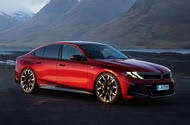BMW is gearing up for a transformative shift in its lineup, particularly focusing on its combustion-powered models. This overhaul is not just a cosmetic update; it’s a strategic move to align these vehicles with the brand’s upcoming electric offerings, particularly the Neue Klasse series. Let’s dive into what this means for BMW enthusiasts and potential buyers.
What’s Changing in the BMW Lineup?
The first major update will be the 5 Series, which is set to receive a significant facelift next year. Although the eighth-generation model was only launched in 2023, recent spy shots suggest that BMW is already preparing to refresh its design. This update will include a bold new front end that aligns with the aesthetics of the Neue Klasse models, signaling a new era for the brand.
But it’s not just about looks. Inside, we can expect a makeover that might include the innovative Panoramic iDrive system. This new setup features a sleek dashboard, an expansive head-up display, and a 17.9-inch touchscreen, all while eliminating physical buttons for a cleaner, more modern interface. The iX3 will be the first to showcase this technology, followed by the entire BMW range.
How Will Performance Change?
Despite these updates, the 5 Series will maintain its current CLAR architecture for now. This means that the powertrains will remain familiar, offering either a 205bhp mild-hybrid or a 295bhp plug-in hybrid option, both powered by a 2.0-liter four-cylinder turbo engine. The high-performance M5 is expected to retain its robust 4.4-liter V8 PHEV setup, delivering an impressive 717bhp.
Following the 5 Series, BMW plans to refresh several other models, including the X5, 2 Series, 7 Series, and X7. This comprehensive update strategy is designed to ensure that all models maintain a coherent look and feel, even as they transition into the new electric-first architecture.
Why Is BMW Making These Changes Now?
According to Bernd Körber, BMW’s product boss, the Neue Klasse represents a significant leap in design and technology. The upcoming models will be built on a battery-electric vehicle (BEV) platform, starting with the iX3 and the next-generation 3 Series. This shift is not just about keeping up with competitors; it’s a response to the rapidly evolving automotive landscape. As Körber puts it, the pace of technological advancement and societal demand for change has accelerated, prompting BMW to adapt quickly.
Adrian van Hooydonk, BMW Group’s design chief, emphasized the importance of a unified design language across the lineup. He noted that the new models should not make existing cars feel outdated. Instead, the goal is to create a family resemblance while allowing each model to maintain its unique character. This approach is crucial for retaining customer loyalty while attracting new buyers.
What’s Next for BMW?
Looking ahead, the 1 Series is expected to be the next model to undergo a transformation, likely following the X5 in 2028. Meanwhile, core models like the 2 Series and 7 Series, which were introduced just a few years ago, will receive substantial facelifts by 2029. This will include updates to design, interior layout, powertrain technology, and overall functionality.
However, it’s worth noting that older models like the 4 Series and 8 Series may not see the same level of updates. They are nearing the end of their life cycles, and significant changes might not be economically viable.
The big takeaway? BMW’s evolution isn’t just about aesthetics; it’s about embracing a future where technology and design go hand in hand. As they roll out these updates, expect a blend of innovation and tradition that keeps the brand at the forefront of the automotive industry. If you’re a BMW fan or considering a purchase, keep an eye on these exciting developments—they could redefine what it means to drive a BMW in the coming years.

